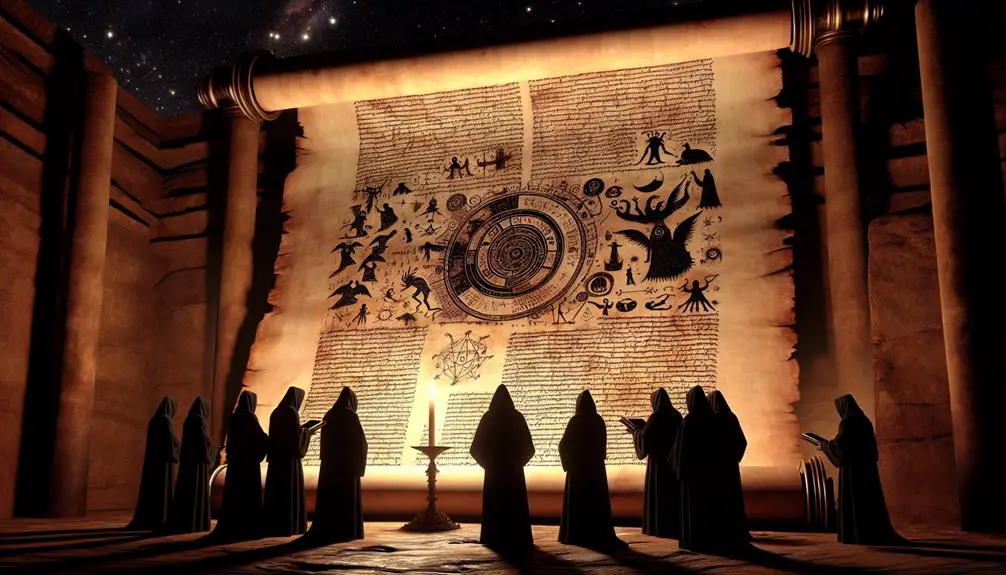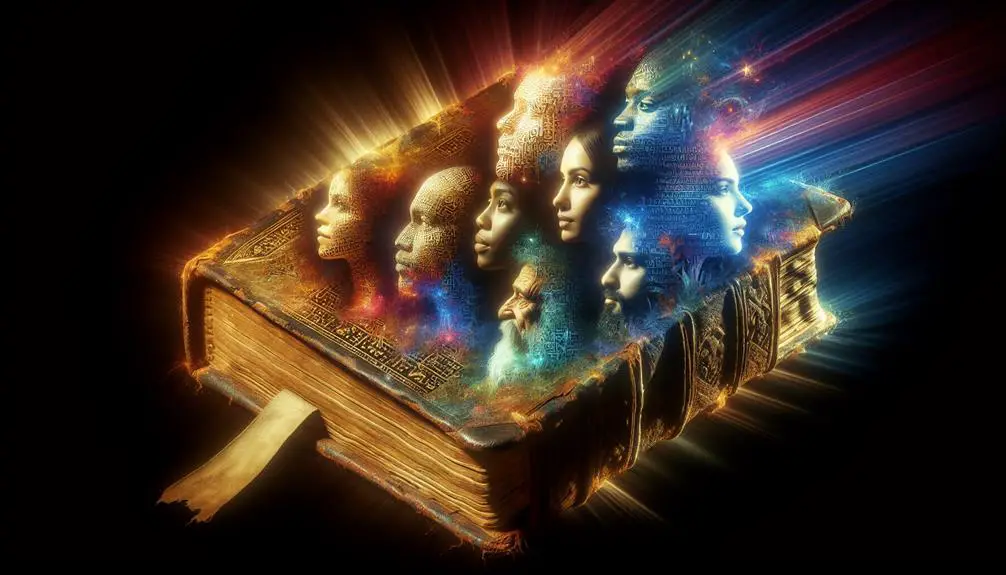Immerse yourself in the hidden mysteries of the Bible, where ancient secrets and enigmatic symbols await to uncover truths untold.

Secrets in the Bible
The Bible, revered as a cornerstone of religious faith and moral guidance, also harbors an intriguing array of secrets and mysteries that have baffled scholars for centuries. From the enigmatic numerology that threads through its texts to the cryptic symbols whose meanings remain disputed, these hidden aspects invite a deeper exploration into the spiritual and historical contexts of the sacred scriptures.
As we peel back the layers of controversial interpretations and probe into the tales of lost books and hidden prophets, a question emerges: What truths lie concealed within these ancient narratives, and how might they alter our understanding of the biblical canon?
Key Takeaways
- Numerology and symbolism offer deeper insights into biblical texts beyond their literal meaning.
- Hidden prophets and prophecies reveal lesser-known aspects of biblical narratives and theological concepts.
- Apocryphal texts and Gnostic Gospels provide alternative viewpoints and enrich understanding of early Christian beliefs.
- Mysterious locations like the Garden of Eden and the Tower of Babel carry profound symbolic significance in biblical stories.
The Numerology of Sacred Texts

Numerology, an ancient practice of attributing mystical significance to numbers, plays a pivotal role in unraveling the symbolic layers woven into sacred texts such as the Bible. This discipline, steeped in tradition and scholarly inquiry, offers a unique lens through which to interpret the complex narratives and teachings found within these texts. Central to this examination is the technique known as Gematria analysis, an alphanumeric method that assigns numerical value to words and phrases, revealing hidden meanings and connections that might otherwise remain obscured.
The application of Gematria and the identification of mathematical patterns within the Bible exemplify an analytical approach that transcends mere literal interpretation. Scholars and theologians alike delve into these patterns, seeking to uncover the deeper, often esoteric, messages encoded within the scripture. This pursuit is not without its challenges, as the subjective nature of numerological interpretation can lead to varied conclusions. However, the consistency and recurrence of certain numbers within the biblical text—such as the numbers 7, 12, and 40—underscore a deliberate design, hinting at a divine or inspired origin.
The study of numerology within the context of sacred texts demands a respectful and scholarly attitude, acknowledging the profound spiritual significance these numbers hold for believers. While the quest for understanding may lead to diverse interpretations, it is the shared journey towards greater insight and enlightenment that unites scholars and faithful alike. Through Gematria analysis and the exploration of mathematical patterns, the numerology of the Bible continues to inspire and challenge, offering a rich tapestry of mysticism and wisdom for those who seek to decipher its secrets.
Hidden Prophets and Prophecies

Within the vast and intricate tapestry of the Bible, certain figures and their prophecies remain less illuminated, awaiting scholarly exploration and interpretation.
This segment aims to uncover these obscure prophets and decipher the hidden prophecies they delivered, which may hold significant implications for understanding biblical narratives and theological concepts.
Unveiling Obscure Prophets
The Bible, a rich tapestry of spiritual guidance, also harbors lesser-known prophets and prophecies that merit a closer examination for their profound implications. Among these are figures shrouded in the mists of history, known more through prophet legends than canonical texts. These divine messengers, though not as prominent as their counterparts like Isaiah or Jeremiah, played pivotal roles in the unfolding biblical narrative.
Their messages, often veiled in mystery, contributed to the complex mosaic of biblical prophecy. By delving into the accounts of these obscure prophets, scholars and believers alike can gain insights into the multifaceted nature of divine communication. Their stories, while not always at the forefront of theological discussions, offer a deeper understanding of the breadth and depth of prophetic voices in the Bible.
Deciphering Hidden Prophecies
Exploring beyond the narratives of lesser-known prophets, an examination of hidden prophecies reveals layers of meaning that have influenced theological interpretations and spiritual insights throughout history.
These prophecies, often shrouded in mystery, employ coding messages and symbolic parallels to convey their truths. Scholars scrutinize these texts, decoding the allegorical language and the imagery used to present predictions and divine messages. The process uncovers a complex web of meanings, where historical events and future predictions intertwine, offering a rich tapestry of spiritual guidance and historical perspective.
This analytical journey into the Bible's veiled prophecies illuminates the depth of its wisdom, showcasing a sophisticated method of communication that bridges the divine with the human, transcending straightforward narrative to engage believers in a profound dialogue with their faith.
Lost Books and Scriptures

The exploration of lost books and scriptures within the Judeo-Christian tradition reveals a complex tapestry of historical and theological development.
Apocryphal texts, while not included in the canon, offer profound insights into early Christian thought and practices, presenting an expanded view of biblical narratives.
Investigations into these hidden gospels can illuminate the diverse perspectives and theological debates that shaped early Christian communities.
Apocryphal Texts Overview
Apocryphal texts, often considered the lost books and scriptures, encompass a collection of writings excluded from the canonical Bible for various theological and historical reasons.
These texts, including the Gnostic Gospels, have sparked significant Canonical Debates among scholars and theologians. The Gnostic Gospels, for instance, offer alternative narratives and theological perspectives that diverge from those found in the canonical texts.
The debates surrounding these apocryphal works primarily revolve around their authenticity, historical value, and theological implications. Despite not being included in the standard biblical canon, these texts provide invaluable insights into early Christian beliefs and practices.
Their exclusion raises important questions about the criteria used to determine the canonical status of religious texts and the dynamics of religious authority and orthodoxy within early Christianity.
Hidden Gospel Insights
While the canonical Bible is widely known and studied, the lost books and scriptures offer hidden gospel insights that reveal diverse theological views and narratives absent from the traditional texts. These non-canonical writings provide a rich tapestry of spiritual understanding, often emphasizing parable interpretations and metaphorical teachings that diverge from mainstream Christian orthodoxy.
To add depth, consider the following:
- Parable Interpretations: These lost texts often present alternative readings of Christ's parables, offering nuanced spiritual lessons.
- Metaphorical Teachings: They frequently employ metaphors and allegories to convey complex theological concepts.
- Diverse Theological Views: The scriptures challenge and expand our understanding of early Christian beliefs, showcasing the plurality of thought in early Christianity.
This exploration into hidden gospel insights reveals the multifaceted nature of biblical interpretation and theological diversity.
Cryptic Symbols and Meanings

In the intricate tapestry of biblical narratives, cryptic symbols and their meanings play a pivotal role in conveying deeper theological and moral messages. Symbolic parables and ancient codes, embedded within the text, serve as a bridge connecting the divine to the human, offering layers of interpretation that have fascinated scholars, theologians, and believers alike. These symbols, ranging from simple metaphors to complex allegories, encode profound truths about human nature, divine intentions, and the cosmic struggle between good and evil.
The analysis of these symbols requires a scholarly approach that respects the historical and cultural context in which the Bible was written. For instance, water often symbolizes purification and life-giving power, but its meaning can shift dramatically depending on its narrative context. Similarly, light is frequently associated with divine presence and truth, guiding the faithful out of darkness and ignorance.
Deciphering these ancient codes goes beyond mere academic exercise; it is a spiritual journey that deepens one's understanding of the sacred texts and their relevance to contemporary life. The process of interpretation, known as exegesis, involves careful reading, historical research, and theological reflection. Scholars compare passages, cross-reference symbols, and explore ancient languages to unearth the layers of meaning that the biblical authors intended.
This scholarly pursuit not only enriches one's faith but also fosters a deeper connection with the divine. By engaging with the Bible's cryptic symbols and meanings, believers and scholars alike participate in a millennia-old tradition of seeking wisdom and guidance through sacred scripture.
Mysterious Biblical Locations

Exploring the enigmatic locations mentioned in the Bible reveals another layer of complexity within its sacred pages, inviting a deeper understanding of the spiritual and historical landscapes that shape its narratives. Central to these mysterious locales are the Garden of Eden and the Tower of Babel, each bearing significant theological and philosophical weight. The Garden of Eden, often depicted as paradise lost, serves as the epitome of unattainable purity and divine grace, while the Tower of Babel symbolizes humanity's hubris and the fragmentation of human unity.
In analyzing these mysterious biblical locations, several key aspects emerge:
- Historical and Geographic Uncertainty: Despite extensive scholarly efforts, the precise locations of the Garden of Eden and the Tower of Babel remain speculative. This ambiguity adds to their mystique and invites a myriad of interpretations concerning their symbolic meanings.
- Theological Significance: These locations are not merely historical or geographical points of interest; they are deeply embedded within the theological framework of the Bible, representing pivotal moments in the human-divine relationship. The Garden of Eden symbolizes a lost perfection and innocence, while the Tower of Babel reflects the consequences of human pride against divine will.
- Cultural and Literary Influence: Beyond their scriptural significance, the stories of the Garden of Eden and the Tower of Babel have permeated various aspects of culture and literature, shaping centuries of art, literature, and theological discourse. Their enduring legacy attests to the profound impact of these mysterious locations on human consciousness and creativity.
Controversial Interpretations

Delving into the realm of controversial interpretations within biblical scholarship unveils a complex tapestry of perspectives that challenge traditional understandings and provoke thoughtful debate among theologians and historians alike. This academic exploration often centers on how cultural biases and translation errors have potentially skewed our comprehension of ancient texts, leading to contentious debates over the intended messages and teachings of the Bible.
Cultural biases play a significant role in how biblical narratives are interpreted and understood. Scholars argue that many interpretations have been influenced by the prevailing norms and values of the society in which they were made, rather than strictly adhering to the historical and cultural context of the time when the biblical texts were written. This anachronistic approach can lead to misinterpretations that reflect more about contemporary values than about those of the ancient world.
Translation errors further complicate the study of biblical texts. The Bible has been translated into numerous languages over the centuries, each version potentially introducing its own set of inaccuracies. These errors can stem from a variety of sources, including linguistic challenges, the translator's own biases, or a lack of understanding of the original context. Such inaccuracies can significantly alter the meaning of passages, leading to interpretations that diverge from the original intent.
The interplay of cultural biases and translation errors in biblical interpretation underscores the importance of approaching these ancient texts with a critical and informed perspective. Scholars continue to debate and discuss these controversies, striving for a deeper and more nuanced understanding of the Bible's teachings and historical context.
Frequently Asked Questions
How Do Modern Archaeological Discoveries Impact Our Understanding of Biblical Stories and Their Historical Accuracy?
Modern archaeological discoveries, through methods such as pottery dating and inscription analysis, significantly enhance our understanding of biblical stories and their historical veracity. These scientific techniques provide tangible evidence that can confirm or challenge traditional interpretations of biblical narratives.
Can the Ethical Teachings Found in the Bible Be Reconciled With Some of the Controversial Moral Actions Depicted in Its Narratives?
The juxtaposition of divine justice with human morality presents a complex canvas for ethical analysis.
When examining the ethical teachings in light of controversial moral actions, one navigates the nuanced waters of ethical relativism.
This scholarly exploration respects the historical and cultural contexts of biblical narratives, suggesting that apparent contradictions may, in fact, offer deeper insights into the multifaceted nature of ethics and morality, thus enriching our understanding of ancient texts.
How Has the Translation of the Bible Over Centuries Affected the Original Meanings of Its Texts?
The translation of the Bible over centuries, influenced by linguistic diversity and varying translation methodologies, has significantly impacted the original meanings of its texts.
This process, while aiming to make the scriptures accessible to a broader audience, introduces interpretative variations.
The translation methodologies, ranging from literal to more dynamic equivalence approaches, have played a crucial role in shaping the understanding and interpretation of biblical narratives, potentially altering the conveyed messages and ethical teachings.
In What Ways Have Various Cultures Around the World Integrated Biblical Stories Into Their Own Religious or Mythological Frameworks?
Ironically, the timeless tales of the Bible have not remained confined within its pages but have journeyed across diverse cultures, undergoing a fascinating metamorphosis.
This phenomenon of cultural syncretism, where biblical narratives blend with local mythologies, showcases the fluidity and adaptability of sacred stories.
Through mythological adaptations, various cultures have ingeniously integrated these ancient narratives into their own spiritual tapestries, enriching both their religious landscape and the global understanding of biblical texts.
What Role Do Women Play in the Bible, and How Has Feminist Theology Influenced the Interpretation of Their Stories?
Women in the Bible hold significant genealogical importance and have been recognized for their prophetic roles, embodying both leadership and wisdom.
Feminist theology has re-evaluated these narratives, emphasizing the empowerment and autonomy of biblical women, challenging traditional interpretations that often marginalized their contributions.
This scholarly approach fosters a deeper understanding of women's roles in biblical texts, highlighting their pivotal contributions and reshaping perceptions within contemporary theological discourse.
Conclusion
In conclusion, the exploration of secrets within the Bible unveils a complex tapestry of numerology, hidden prophecies, lost scriptures, cryptic symbols, enigmatic locations, and controversial interpretations.
Such investigations not only enrich our understanding of this sacred text but also challenge scholars to consider the multifaceted layers of meaning that have been debated for centuries.
This inquiry into the Bible's mysteries serves as a testament to its enduring intrigue and its capacity to foster profound reflection on historical, spiritual, and philosophical levels.



Sign up